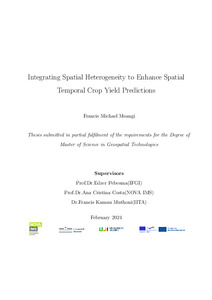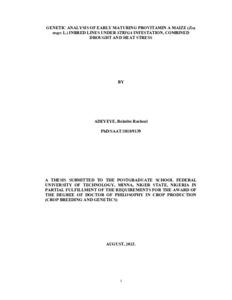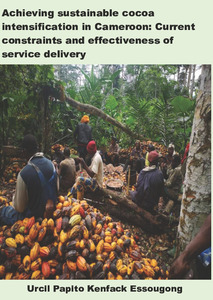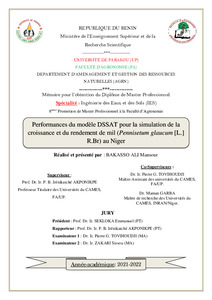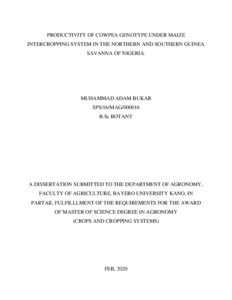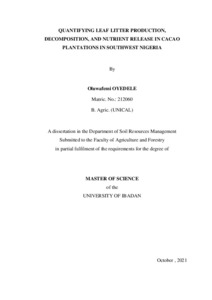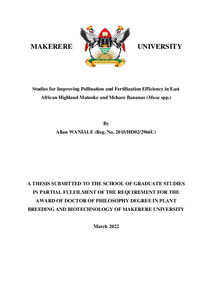Welcome to the International Institute of Tropical Agriculture Research Repository
Theses and Dissertations: Recent submissions
Now showing items 1-20 of 111
-
Delineation of tuber development in African yam bean (Sphenostylis stenocarpa (Hochst ex. A. Rich) Harms
(University of Ibadan, 2021)African yam bean (AYB) belongs to the family Fabaceae. It is an orphan crop with so many potentials that have not been well utilised. It produces both edible seeds and tubers with high nutritional values. However, the crop is grown mainly for the seeds in West Africa, but the tubers are mainly consumed in East and Central Africa. The dual food advantage of AYB is yet to be fully tapped, due to the irregular tuberization in accessions. This study therefore characterised tuber development in AYB ... -
Econometric analysis of disseminating sustainable intensification practices: evidence from Ghana
(Rheinischen Friedrich-Wilhelms-Universitat, 2021)Adoption of sustainable intensification (SI) of agricultural practices is essential for increasing food production in more sustainable way. Dis-adoption of agricultural technologies is pervasive among smallholder farmers in sub-Saharan Africa after withdrawal of most programme interventions. Based on data collected from 700 farm households of an agricultural research for development programme in northern Ghana. This study i) examines alternative ways of inducing farmers into adopting new agricultural ... -
Genetic analysis and drought stress assessment of marker-based improved provitamin-A maize synthetics
(University of Ibadan, 2023-07)Maize is an important staple in Sub-Saharan Africa (SSA) but most varieties are low in Provitamin-A (PVA) carotenoids, and the performance adversely affected by drought stress. Development and adoption of PVA carotenoids-enriched drought-tolerant Maize Synthetics (MS) could help improve maize yields and reduce vitamin A deficiency in SSA. Marker Assisted Recurrent Selection (MARS) could be used to improve the nutritional quality and resilience of maize. However, the effects of MARS on carotenoid ... -
Growth and nutrient uptake response of cocoa seedlings (Theobroma cacao) to different growth media at the nursery
(University of Energy and Natural Resources Sunyani Ghana, 2024-08)A study was conducted in the nursery house of Mabang Megakarya Selection Programme, a substation of the Cocoa Research Institute of Ghana from April 2022 to September 2022 to determine the growth and nutrient uptake response of cocoa (Theobroma cacao) seedlings to different growth media at the nursery. The treatments comprised three base-materials viz: Topsoil (TS), Rice husk (RH) and Sawdust (SD) amended with three rates of rice husk biochar (RHB) at 75%: 25%, 50%:50% and 25%:75% and two rates ... -
Remote sensing-based land degradation assessment to inform sustainable development goal 15.3: a case study in Ghanaian Savannah, West Africa
(University of Bergen, 2024-06)Land degradation (LD) continues to be a global problem affecting humanity and their livelihoods. Like other African countries, Ghana is one of the countries with elevated levels of LD. However, LD assessments in Ghana have been far and wide and it has not been consistent. There have not been any recent assessments done to inform the SDG indicator 15.3.1 in Ghana. This study therefore focused on the Northern, North East, and Upper East of Ghana and bridged the information gaps on LD. This study was ... -
Genetic diversity in African yam bean [Spenostylis stenocarpa (Hochst ex A. Rich.) Harms] collection
(University of Ibadan, 2023-05)African Yam Bean (AYB) is an underutilized legume with great potential of providing an inexpensive and sustainable solution to malnutrition and food insecurity in Sub-Saharan Africa. However, its genetic variability is not yet fully exploited and documented. To enhance the full exploitation and improvement of the crop, there is a need for knowledge of its genetic diversity. This research was therefore carried out to assess the genetic diversity in AYB germplasm collection using agro-morphological ... -
Analysis of historical data for optimization of genomic selection pipeline in cassava
(Cornell University, 2023-08)Breeding for high-yielding and broadly adapted varieties of cassava has been the primary target of the International Institute of Tropical Agriculture (IITA) cassava breeding program based in Nigeria. However, this target has been hindered due to the presence of genotype-by-environment interaction (GEI) and phenotypic recurrent selection as a traditional approach of breeding. This approach generates gains slowly due to long breeding cycle, resulting to low rate of realized genetic gain per unit ... -
Trees and shrubs forage in the eastern Democratic Republic of the Congo: determinants of utilization, nutritive value and effect of supplementation on the lactation performance of crossbred cows
(Jomo Kenyatta University of Agriculture and Technology, 2023)Smallholder dairying is particularly important as milk produced provides nutrients and income to the households. Its expansion is thus desirable in alleviating poverty and enhancing food and nutrition security. Despite its importance, feed quantity and quality (protein and energy levels) are inadequate and rarely meet the nutrient requirements of lactating crossbred cows in Kalemie and Kabare territories, in the eastern Democratic Republic of the Congo (DRC). Milk production of cows fed on Guatemala ... -
Simple sequence repeat markers and endogenous phytochemicals associated with somatic embryogenesis in Dioscorea alata L. and Dioscorea rotundata poir
(University of Ibadan, 2021-12)Yams (Dioscorea species) are important staples in Africa, propagated mostly through organogenesis in vitro with low multiplication ratio (1:4). This can be improved through Somatic Embryogenesis (SE) as reported in other crops. However, there is inadequate information on genes and endogenous phytochemicals regulating yam SE necessary for optimising SE protocols in target genotypes. Therefore, this study was conducted to identify Simple Sequence Repeat (SSR) markers and endogenous phytochemicals ... -
Diversity studies in 21 maize (Zea mays L.) accessions based on agro-morphological characters and diversity array technology (DArTs)
(Federal University of Agriculture Abeokuta, 2023-03)Maize (Zea mays L.) is one of the most important crops in the world, being among the main sources of human food, animal feed, and industrial raw material. Landraces have certain genetic integrity, which is recognizable morphologically and by farmers. Maize grain yield is influenced by environmental conditions that can either boost production or retard its development, hence the need to determine the enormous genetic diversity in maize and identify accessions with good adaptability in contrasting ... -
Developpement agricole, genre et securite alimentaire: une analyse comparative des menages ruraux dans les zones montagneuses du territoire de Kalehe (RDC) et du district de Rusizi (Rwanda)
(University of Liege, 2023-07)Dans la région des grands lacs africains, et plus particulièrement dans les milieux ruraux de la RDC et du Rwanda, le secteur agricole joue un rôle prédominant dans l’économie locale et constitue le principal moyen de subsistance des ménages. Ce dernier, évalué en termes de capital financier, humain, matériel, naturel et du capital social favorise le développement agricole des ménages. Malheureusement, dans les zones rurales de la RDC et du Rwanda, mobiliser ces différentes formes de capital pour ... -
Developpement d'une farine infantile a forte valeur nutritionnelle pour les enfants de 6 A 12 mois valorisant la biodiversite locale
(Universite Nationale d'Agriculture, 2022)Les aliments de complément pour les enfants de 6 à 12 mois sont importés ou manufacturés localement. Au Mali, on observe une faible production locale alors que le pays dispose de diverses ressources endogènes. L’objectif de cette étude est de contribuer à la réduction de la prévalence des carences en micronutriments chez les nourrissons du deuxième âge (enfants de 6 à 12 mois), par la valorisation de la biodiversité locale au Mali. Les caractéristiques nutritionnelles du maïs, de l’arachide, du ... -
Evaluation de l'efficacite de l'Aflasafe dans la lutte contre l'Aspergillus spp. synthetisant l'aflatoxine dans les bassins de production de sorgho, de mais et de l'arachide au Mali
(rsity of Bobo Dioulasso, 2023-03)Les aflatoxines sont des mycotoxines dont l’exposition chronique engendre des problèmes graves de santé comme le cancer du foie, le retard de croissance des enfants et l’affaiblissement du système immunitaire. Elles sont couramment rencontrées dans les denrées alimentaires cultivées comme le sorgho (Sorghum bicolor (L.) Moench), le maïs (Zea mays L.) et l’arachide (Arachis hypogaea L.). Aflasafe est un bio pesticide préconisé pour lutter contre les champignons producteurs des aflatoxines. L’objectif ... -
Integrating spatial heterogeneity to enhance spatial temporal crop yield predictions
(Universidade NOVA de Lisboa, 2024-02)Crop yield predictions and monitoring are important in understanding key challenges in crop production and management to ensure the effective utilization of resources to enhance food security. Over the years remote sensing data and machine learning models have been employed with the help of ground truth data as reference in the estimation of crop yields across space and time. However, the common machine learning methods often overlook the spatial heterogeneity inherent in regions leading to ... -
Genetic analysis of early maturing provitamin A maize (Zea mays L.) inbred lines under Striga infestation, combined drought and heat stress
(Federal University of Technology Minna, 2023-08)High yielding and stable early maturing provitamin A (PVA) maize hybrids with combined stresses (drought and heat and Striga) tolerance are needed to combat malnutrition, low yield and insecurity in sub-Sahara Africa (SSA). To address this need, PVA, PVA-QPM (quality protein maize) inbred lines with Striga and drought tolerant genetic make-up were developed through the massive effort of the International Institute of Tropical Agriculture Maize Improvement Program (IITAMIP) for its hybrid ... -
Achieving sustainable cocoa intensification in Cameroon: current constraints and effectiveness of service delivery
(Wageningen University & Research, 2023-12-18)This thesis aims to increase our understanding of the current constraints to sustainable cocoa intensification in Cameroon and the extent to which service delivery in the sector is adequate. To this end, four levels of analysis are considered: farmers' perceptions of cocoa farming practices and ability to innovate; the socio-economic, socio-demographic, and farm factors that influence the intensity of adoption of cocoa best management practices (BMPs), cocoa yield, and net returns; the availability ... -
Performance of DSSAT model for the simulation of millet (Pennisetum glaucum [L.] R.Br) growth and yield in Niger
(University of Parakou, 2022-11)Résumé Le mil (Pennisetum glaucum (L.) R. Br.) représente la principale céréale la plus utilisée et cultivée au Niger. Néanmoins, une baisse de production qui est due à plusieurs facteurs dont la pauvreté des sols et une inégale répartition de pluie dans le temps et dans l’espace. Cette dernière se traduit par un retard au niveau des installations des campagnes agricoles. Le choix de la date de semis et des variétés appropriées reste l’une des options pour faire face à ce problème. Cette étude a ... -
Productivity of cowpea genotype under maize intercropping system in the northern and southern Guinea Savanna of Nigeria
(Bayero University Kano, 2020-02)A field experiment was conducted in 2018 rainy season at the International Institute of Agriculture Research Farms at Abuja and Zaria to know the adaptability of cowpea genotype to maize canopy in northern and southern Guinea savannah of Nigeria. The experiment consisted of 12 treatment combinations; of three cowpea varieties (SAMPEA 11, SAMPEA 14, and UAM09-126-19-2) in two cropping systems (sole and intercropped with EVDT99) and at two relay dates (5 and 8 WAS). The treatments were laid out in ... -
Quantifying leaf litter production, decomposition, and nutrient release in cacao plantations in southwest Nigeria
(University of Ibadan, 2021-10)Nutrient cycled from litterfall plays an important role in sustaining the fertility status in cacao (Theobroma cacao L.) plantations. However, the role of macrofauna in regulating the rate of decomposition and nutrient release remains uncertain despite its importance in litter decomposition and nutrient release. The study was carried out to assess the quantity and seasonal pattern of annual litterfall production in low-shade cacao plantations found in Southwestern Nigeria and also to determine the ... -
Studies for improving pollination and fertilization efficiency in East African Highland Matooke and Mchare Bananas (Musa spp.)
(Makerere University, 2022-03)Matooke and Mchare are two distinct subgroups of East African bananas (EABs) (Musa spp.) that are endemic to the Great Lakes region of East Africa. In this region, they are pivotal in for food and income security of more than 70 million people. However, productivity of these EABs is significantly constrained by pests and diseases that reduce the yield and directly affecting the livelihoods of banana farming communities in the region. While cultural methods of disease and pest control are widely ...





